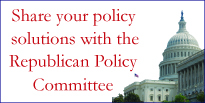RPC Reg Spotlight August 2, 2011
Regulatory Action in the Spotlight:
Proposed Corporate Average Fuel Economy (CAFE) mandate increased to 54.5 mpg
Adverse Effects:
- More expensive for consumers
- Potential increase in traffic deaths
- Switching dependency from the Middle East to China
Response of the Obama Administration:
The Obama administration revealed a proposal on July 29, 2011, to nearly double Corporate Average Fuel Economy (CAFE) standards, from the current 27.5 miles per gallon and the mandated 35.5 mpg by 2016 (75 Fed. Reg. 25324), to 54.5 mpg by 2025. Currently, no single non-electric vehicle achieves the 54.5 mpg standard, and few meet the current fleet average mpg standard of 35.5 mpg mandated in four short years.
Impact on the United States:
The Center for Automotive Research, in a June 2011 report, estimates the new CAFE standards will eventually raise net vehicle prices by over $11,000. This net number includes the savings realized from improved gas mileage. Industry insiders acknowledge the only way to meet the fleet mpg goals will be for automakers to build hybrid and electric cars. Yet, the $7,500 federal income tax credit currently available to purchase an electric vehicle has not resulted in the public buying them in appreciable numbers.
Aerodynamic design and proper tire inflation can only improve fuel efficiency so far. The most effective method of increasing fuel economy is to make cars smaller and lighter, but this also makes them more dangerous. A 2003 study by the National Highway Transportation Safety Administration found that reducing a vehicle's weight increased fatality rates from 1.4 percent for a vehicle weighing 4,000 to 4.26 percent for vehicles weighing 2,500 pounds. Vehicles heavier than 4,000 pounds actually show a decrease in fatalities. Sam Kazman of the Competitive Enterprise Institute noted, “SUVs heavier than 4,500 pounds have a death rate less than one-third that of cars under 2,500 pounds.”
The manufacture of higher fuel economy vehicles powered by electric and hybrid motors requires the greater use of rare earth metals. These metals are included in such components as electric motors and generators, batteries, and sensors. Demand is high for these metals, supply is limited, and the major supplier is China, followed by Russia and Brazil. Daniel McGroarty at the American Resources Policy Network notes, “Right now, China provides 97 percent of global Rare Earths production. The U.S. provides a fraction of one percent…China has 36 percent of known reserves, with the U.S. accounting for 13 to 15 percent.” In a rush to reduce our dependence on foreign sources of oil, the United States may now become dependent on China to produce components of our automobiles.
In Closing:
The Obama administration proposal to increase fuel economy to a fleet average 54.5 mpg carries with it the prospect of more expensive vehicles, dependence on China for production, and increased highway fatalities. In 2009, the Insurance Institute for Highway Safety reported: "Occupants of smaller cars are at increased risk in all kinds of crashes, not just ones with heavier vehicles. Almost half of all crash deaths in [small cars] occur in single-vehicle crashes, and these deaths wouldn't be reduced if all cars became smaller and lighter." The major automakers have voiced their support for the higher CAFE standards of 54.5 mpg by 2025. Observed by Bill Vlasic in The New York Times, “In the end, though, Detroit was faced with an undeniable political reality: there was no graceful way to say no to an administration that just two years ago came to its aid financially.”
Relevant Legislation:
On July 21, 2011, a bipartisan group of 16 Michigan lawmakers sent a joint letter on fuel economy rules to the White House. The letter expressed concerns over upcoming fuel efficiency targets for 2017 to 2025 that, if handled improperly, could have a negative impact on the economy of a state currently experiencing 10.5 percent unemployment. Of particular interest is the standard for light-duty trucks, which the delegation suspects may be beyond what is technologically achievable. Additionally the proposed standards cover a time period that is, “unprecedented in the history of fuel economy rulemaking,” stretching nearly 15 years into the future. Congress had limited the NHTSA to set fuel economy standards no more than five model years at a time to prevent standards from being based on speculation or unreliable market and technology projections. The delegation asked the White House for, “a balanced approach to fuel economy regulation with reasonable and achievable targets that will reduce our consumption of oil…while preserving U.S. jobs and promoting U.S. manufacturing.”

